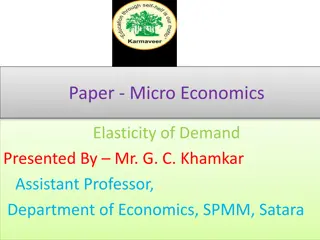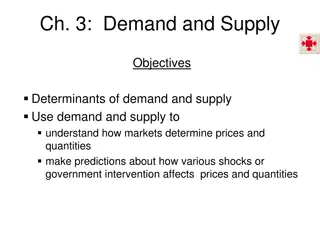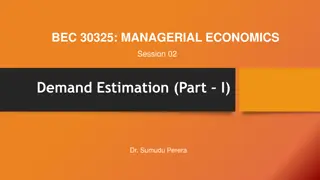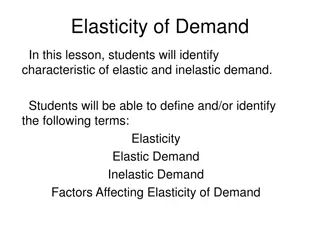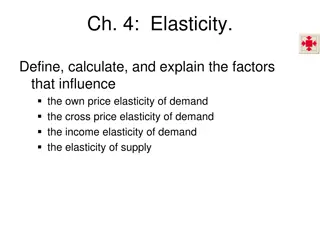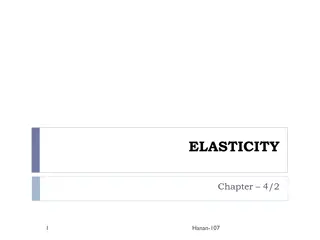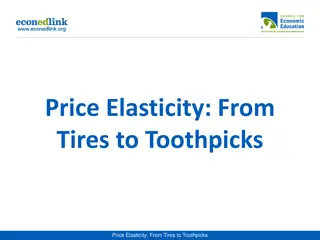Understanding Elasticity of Demand in Economics
Elasticity of demand refers to the responsiveness of quantity demanded to changes in factors like price, related commodities, and consumer income. This concept helps analyze how demand fluctuates with price changes, with examples and calculations provided. Interpretations of numerical values and the importance of price elasticity are also explained in detail.
Download Presentation

Please find below an Image/Link to download the presentation.
The content on the website is provided AS IS for your information and personal use only. It may not be sold, licensed, or shared on other websites without obtaining consent from the author. Download presentation by click this link. If you encounter any issues during the download, it is possible that the publisher has removed the file from their server.
E N D
Presentation Transcript
Elasticity of Demand By Dr. Dr. V.S. V.S. Karpe Karpe Dept. of Economics Sarvajanik Arts & Commerce College, Visarwadi, Tal. Navapur, Dist. Nandurbar (MH)
Examples As a result of fall in the price of radio from Rs. 500 to Rs. 400, quantity demanded increases from 100 radios to 150 radios. As a result of fall in the price of wheat from Rs. 10 per kg to Rs. 9 per kg, the demand increases from 500 kgs to 520 kgs. As a result of a fall in the price of salt from Rs. 3 per kg to Rs. 2.50 per kg, the demand increases from 1000 to 1005 kgs.
Definition Elasticity of Demand as the responsiveness of the quantity demanded of a good to changes in one of the variables on which demand depends. It is the percentage change in quantity demanded divided by the percentage change in one of the variables on which demand depends. These variables are price of the commodity, price of the related commodities, income of the consumers.
Price Elasticity It expresses the response of quantity demanded to a change in its price, ceteris paribus. Price Elasticity = Ep Ep = % change in quantity demanded ------------------------------------------------ % change in price Ep= Change in quantity X Original price ------------------------ ------------------------ Change in price Original quantity
Example The price of a commodity decreases from Rs. 6 to Rs. 4 and the quantity demanded increases from 10 units to 15 units. Find the co-efficient of price elasticity.
Interpreting numerical values of elasticity of demand The numerical value of elasticity of demand can assume any value between zero and infinity Elasticity is zero, if there is no change in quantity demanded when price changes. Elasticity is one if the percentage change in quantity demanded is equal to the percentage change in price.
Interpreting numerical values of elasticity of demand Elasticity is greater than one when the percentage change in quantity demanded is more than the percentage change in price. Elasticity is less than one when the percentage change in quantity demanded is less than the percentage change in price Elasticity is infinity when a small reduction in price raises the demand from zero to infinity.
N u m e r ic a l m e a s u r e o f D e s c r ip t io n T e r m in o lo g y e la s t ic it y Z e r o Q u a n t it y d e m a n d e d P e r fe c t ly in e la s t ic d o e s n o t c h a n g e a s p r ic e c h a n g e s G r e a t e r t h a n z e r o , b u t Q u a n t it y d e m a n d e d In e la s t ic le s s t h a n o n e c h a n g e s b y a s m a lle r p e r c e n t a g e t h a n t h e p r ic e r is e O n e Q u a n t it y d e m a n d e d U n it e la s t ic c h a n g e s b y t h e s a m e p e r c e n t a g e a s t h e c h a n g e in p r ic e G r e a t e r t h a n o n e b u t Q u a n t it y d e m a n d e d E la s t ic le s s t h a n in fin it y c h a n g e s b y a la r g e r p e r c e n t a g e t h a n t h e p r ic e r is e In fin it y P u r c h a s e r s a r e p r e p a r e d P e r fe c t ly e la s t ic t o b u y a ll t h e y c a n o b t a in a t s o m e p r ic e a n d n o n e a t a ll a t a n e v e n s lig h t ly h ig h e r p r ic e
Methods of measuring elasticity Percentage method ( Suppose quantity demanded of coconut is initially 800 units at a price of Rs. 10 and increases to 1000 units when price falls to Rs. 8. Calculate price elasticity of demand of coconut)
Point elasticity of demand Refers to measuring the elasticity at a particular point on the demand curve. Defined as dq/dp x p/q Where dq/dp is the derivative of quantity q w.r.t price p on the demand curve. Point elasticity = Upper segment / Lower segment
Arc Elasticity method Arc elasticity measures elasticity at the mid point of an arc between any two points on a demand curve. Elasticity = q1-q2/q1+q2 X p1 +p2/ p1-p2 Where p1 = original price q1 = original quantity p2 = new price q2 = new quantity
Total outlay method Elasticity is measured by comparing expenditure levels before and after any change in price. Elasticity of demand E p > 1 Price Increases Decreases Same Increases Decreases Total expenditure Decreases Increases Unchanged Increases Decreases Ep=1 Ep<1
Determinants of price elasticity of demand Availability of substitutes Proportion of income spent on the commodity Nature of need that the commodity satisfies Number of uses to which a commodity can be put Time Consumer habits Price range
Income elasticity of demand Income elasticity is the degree of responsiveness of quantity demanded to a small change in the income of the consumers The relationship between income elasticity of goods and proportion of income spent on it can be described in the following propositions.
Propositions If the proportion of income spent on goods remain the same as income increases, then income elasticity for the goods is equal to one. If the proportion of income spent on goods Increases as income increases, then income elasticity for the goods is greater than one If the proportion of income spent on goods decreases as income increases, then income elasticity for the goods is less than one
Positive Income elasticity of demand When with an increase in the income of the consumer, the demand for the good increases and vice versa. It is positive in case of normal goods
Negative Income elasticity of demand When increase in income of the consumer is accompanied by a fall in the demand of goods It happens in case of inferior goods or Giffen goods
Zero Income elasticity of demand When change in the income of a consumer does not have any effect on the demand Demand for necessaries like oil, salt etc have zero income elasticity of demand
Cross Elasticity of Demand Cross elasticity of demand is the change in the demand of one good in response to a change in the price of another good. --------- X py Where Ec = Cross elasticity of demand qx = original quantity demanded of X qx = Change in quantity demanded of X py = Original price of Y py = Change in Price of Y Ec = qx py ----------- qx
Positive cross elasticity of demand It is positive in case of substitute goods. For ex, a rise in the price of coffee will lead to a rise in demand for tea. The curve slopes upward from left to right
Negative cross elasticity of demand It is negative in case of complementary goods For ex, an increase in the price of bread will lead to a fall in the demand for butter The curve slopes downward from left to right
Zero cross elasticity of demand Cross elasticity demand is zero when two goods are not related to each other. For ex, rise in the price of wheat will have no effect on the demand for shoes.
Read the following data and answer the questions XYZ are 3 commodities. X and Y are complements whereas X and Z are substitutes. A shopkeeper sells commodity X at Rs. 40 per piece. At this price he is able to sell 100 pieces of X per month. After some time he decreases the price of X to Rs. 20. Following the price decrease: He is able to sell 150 pieces a month The demand for Y increases from 25 units to 50 units The demand for commodity Z decreases from 150 units to 75 units
Quiz The price elasticity of demand when the price of X decreases from Rs. 40 to Rs. 20 will be equal to : 1.5 1.0 1.66 0.6
Quiz The cross elasticity of demand for Y when the price of X decreases from Rs. 40 to Rs. 20 is equal to: +1 -1 -1.5 1.5








